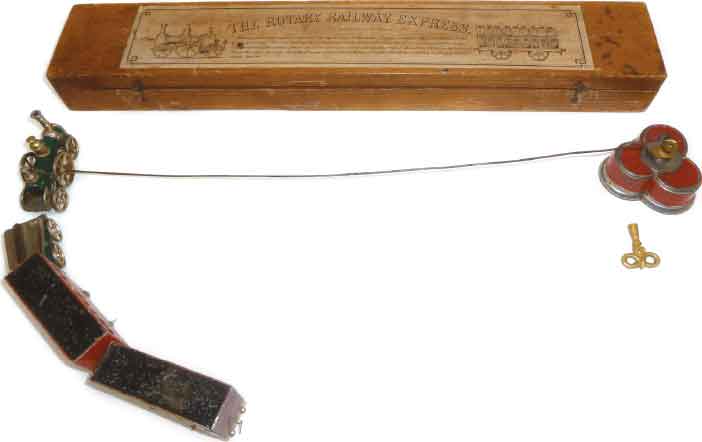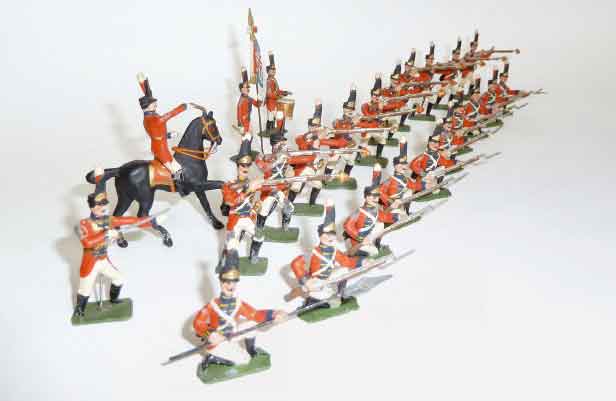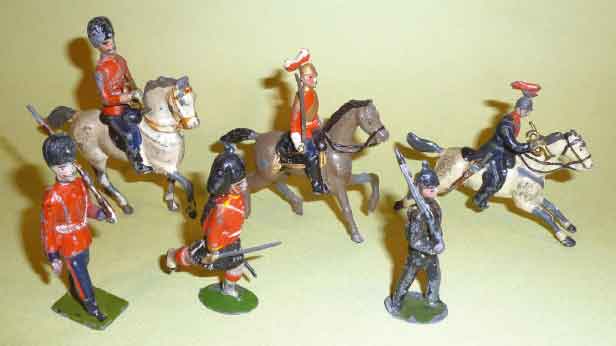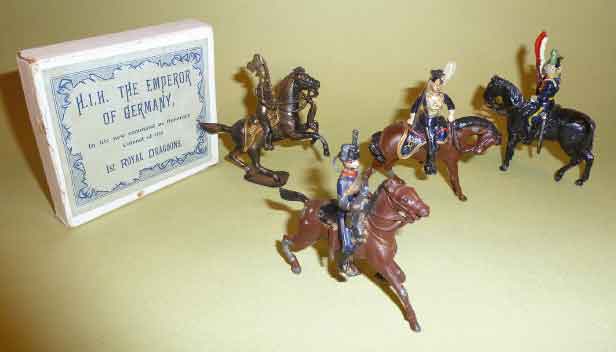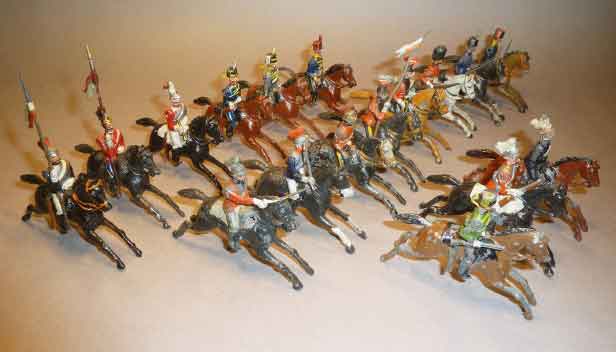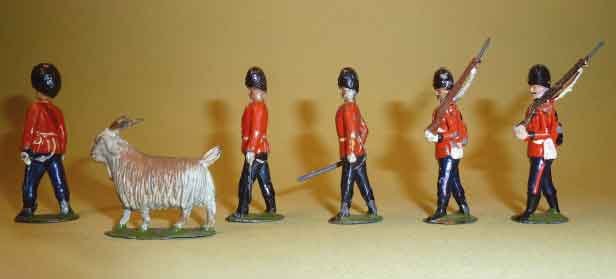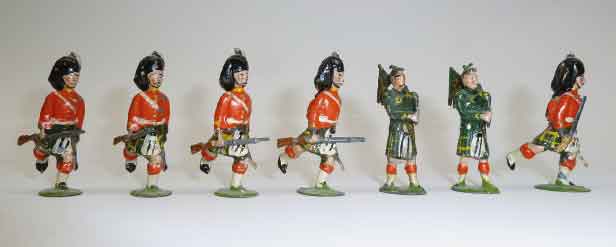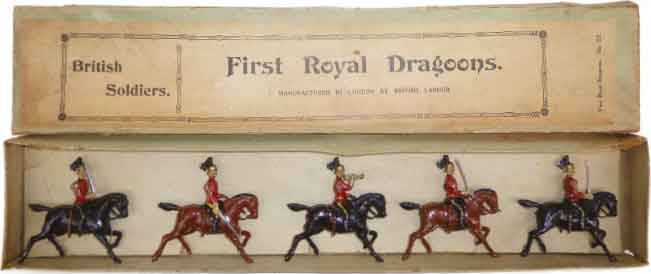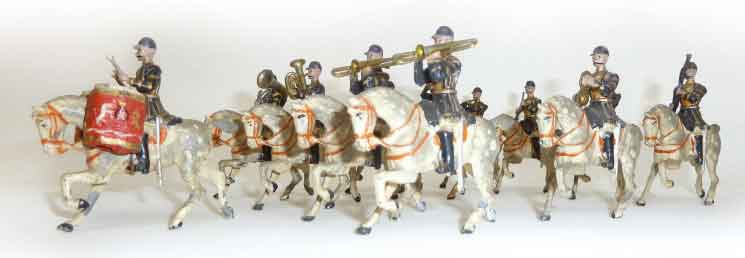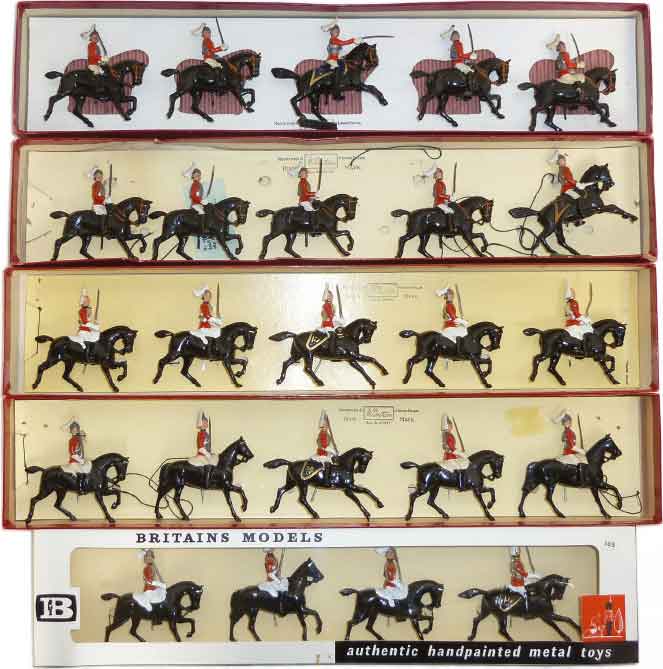Start-up 1893-1899
The Toy Industry in Britain in the 1890s. The Britain family before 1893. Germany leads the world in toymaking. How it all began. Hollowcasting. Test models. Breaking into the market. The first Souvenirs. Queen Victoria’s Diamond Jubilee. Heroes of the Sudan. Defining Versions and Variations. Collecting Ancient Britains. The first hundred sets.
In these seven years, the Britains family perfected a new product, hollowcast toy soldiers. Both manufacturing and distribution were different from the imported toy soldiers previously available in British toyshops. The method of manufacture, the range available, the attention to detail, the advertising and marketing, all contributed to a mass market success that was very much a product of its time. By mid-1900, Britains had become, on a small scale, a national institution, a success story in the making. Most of the problems were connected with expansion and moving faster than the burgeoning competition, both innovatively and reactively.
As this was the first age, everything was new, and during it the first cavalry, infantry, artillery, bands, marching, firing, foreign, colonial, naval, personality and souvenir figures all appeared among the first hundred sets of best quality large figures, along with small size and probably second quality figures as well.
While William Britain Senior provided a grand old head of the family, several of the five brothers in the next generation were playing a leading part in operations, most notably William Britain Junior, forty-one at the turn of the century, who designed most of the figures, and his younger brothers Alfred and Frederick who were engaged primarily in management and sales respectively. All having been in at the start, it is likely that each of them were capable of any of these roles. We know that Alfred designed some very nice figures, dated in 1907. It was the father and these three sons who were the partners in William Britain and Sons, the partnership as which the firm was organised in its early years.
The British Toy Industry in 1890
Towards the end of the reign of Victoria, all seemed reasonably well with the British Empire. The ‘scramble for Africa’ was in full swing, and success in dominating that continent, fending off European rivals by agreeing lesser prizes, seemed assured. That this had been accomplished without sparking a major conflict was possibly the greatest achievement of the ‘Pax Britannica’. In spite of normal cycles of boom and bust, post-Industrial Revolution Britain was relatively prosperous, reaping the benefits of peace and worldwide trade increasingly fostered by improving rail, steamship and telegraphic communications. It was a time of change and hope comparable to today.
This atmosphere fostered the growth of a world toy industry that had not previously existed. While children had always played with objects that they found or had been fashioned for them, only the better off had been able to afford good workmanship in their toys. The industrial revolution made possible the manufacturing and distribution of all sorts of consumer goods to a wider public. Mass-market toy manufacturing in Britain, however, got off to a slow start. The British were the earliest into industrialisation, and as such were continuing to exploit the basics, coal, steel, transport, food, medicine and cloth, which together with finance and empire building were at the forefront of commerce.
Toys, however, were much less well established, and while the skills were certainly there, there were no large enterprises of manufacturing, even if there were plenty of wholesalers and retailers. Much of what was sold was made locally, and many of the retailers were not specifically toy specialists, but combined what we would now think of as toys with sporting goods or giftware. By far the majority of all British toymakers were individual craftsmen, perhaps utilising family or friends, but in hard times falling back on other crafts, or making a few toys for the Christmas market. This is not to say that there were not plenty of toys, because toy making was widespread as a source of extra income, as it has continued to be. One Charles Chaplin, for instance, made such a sortie into toys at an early age.
The Britain Family
William Britain Senior, founder of the Britain dynasty, was apprenticed as a brass finisher. Married in 1852 at the age of twenty-one, his wife Anna Maria proceeded to give birth to a typical Victorian family of four daughters followed by five sons. Less typically, only one of the daughters failed to survive into the 20th Century, and evidently the family was not too impoverished. They moved steadily up the property ladder as their fortunes improved. The 28 Lambton Road house which became the core of the later toy soldier factory was only the family home for a period before 1893, and was probably in use for toy production after the family moved out, with at least two of the sons moving to new matrimonial homes.
The Britain toy business was reckoned as substantial in the toy trade before 1893 and it was as manufacturers of mechanical toys that they first made their name, trading by 1893 as W. Britain & Sons. Just how substantial remains a mystery, but a catalogue of that period still exists showing twenty-three different and relatively expensive mechanical toys. Once the Britains had switched their main efforts to toy soldiers, Alfred Britain recalled the previous years as having been somewhat precarious, as the German toy industry had become increasingly competitive in the novelty mechanical toy market. ‘We were in a difficult position. Something had to be done’. That something turned out to be the launch of Britain’s Toy Soldiers, and the ongoing consequences are the subject of the rest of this book.
The Toy Soldier Trade in 1893
Today we may well forget by just how much the armed forces were important in society towards the end of the 19th century. In Great Britain, the Royal Navy was the senior service, and half the not very large and generally volunteer army tended to be overseas as Empire policemen. Not on the European Continent – there, every boy knew that they were in for a period of service as a conscript. Huge rivalries existed between the great powers of France, Germany, Austria and Russia, with Germany steadily in the ascendant and Italy shaping up to join in. A vast pool of trained potential soldiery was needed in every country so that the politicians could join in this game, or at least strike a credible posture of defiance. War was always a possibility.
Picture 13: The Rotary Express
This was a very early toy marketed by the Britains family. It is a railway floor toy depicting a train looking as though it dates from the 1850s. By the time of the only known surviving Britains undated toy catalogue, probably from before 1893, this toy is no longer featured. The train with two carriages is pulled round the motor by clockwork. When it comes to a stop, one carriage is discarded, after which the clockwork can take it a bit farther, at which point a second carriage can be uncoupled. Then the engine alone can travel again, a total, the box lid declares, of some 300 feet in all. B
Germany and France both had a tradition of toy soldier manufacture during the 19th century, with large varieties of solid cast metal figures from flat through semi-flat to fully round models. German flat figures were the most widely sold in Britain, and the cheapest. Small semi-flats around 30mm scale were also popular, and there were also rather rounder figures at about the same size. Figures larger than this were more recent and relatively expensive, but were there for the asking, and often extremely well made and painted.
German toy soldier makers* active at this time included Georg Heyde, Georg Spenkuch, Johann Haffner, the brothers Heinrich, and Karl Krause. Those most energetically engaged in exporting to Great Britain were Heyde, Heinrich, often branded as Noris, and Haffner, in that order of volume. From France, the products of CBG Mignot occasionally appeared in British shops, but by far the major volume of imported toys at this period came from Germany. Indeed, about half of the toy importers established in this country were actually Germans**.
Since there were no commercial toy soldier makers native to Britain at this time, all of the demand was being fulfilled by imports or crude homemade products. This had been true for so long that most people took it for granted that toy soldiers came from Germany.
* The best authors for German toy soldiers is the late Hans Henning Roer, Old German Toy Soldiers Palagonia Verlag 1993 and Pictorial Handbook for the Identification of German Toy Figures in Lead by Hanns Roth
** Kenneth D. Brown The British Toy Business Hambledon Press 1996
Picture 14: Heyde Napoleonic British Infantry
These 47mm scale solidcast infantry are typical of the best small scale product of Georg Heyde, the leading German manufacturer in 1893. Note the variety of poses and the plentiful extras: officers on foot and mounted, colour bearer and drummer. These additional figures were normal in sets of German and French toy soldiers. CONDITION: these were made of a high lead content alloy, and so susceptible to oxidisation, which can be seen here where the paint has been worn away as a powdery grey look to the bare metal. Good to Fair (G-F). B
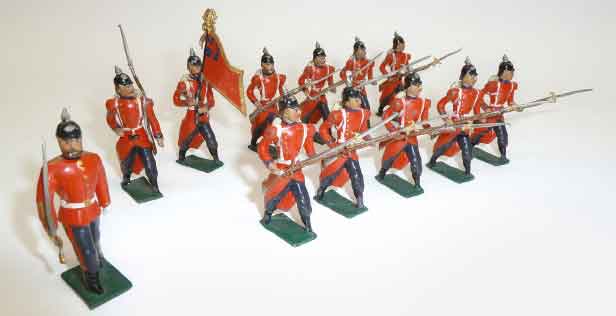
Picture 15: CBG Mignot early British Infantry of the Line
These may well pre-date 1893, and similar figures have been taken into account in deciding on the scale of Britains first soldiers. The on guard sets 16-18 were of a very similar size. The CBG Mignot soldiers are very attractive, but any British boy would know that British greatcoats are grey. CBG were using a French figure that would normally have a greatcoat, with a German head to get a British result.
The Britain family makes a start in toy soldiers
As with any family firm struggling to make ends meet, records of how decisions were made and what exactly took place at the start of the switch to toy soldiers do not exist.
The best evidence remains that connected with surviving examples of their earliest products, but based on the slenderest of evidence there is one other possibility that fits nicely with Inherent Commercial Probability.
Gamages 1913 catalogue says that their ‘famous Toy Galleries’ started twenty years ago – in 1893, and this mention is made in the heading to the toy soldier pages. Maybe this infers that the start of a much larger Gamages toy department went hand in hand with the start of Britains toy soldiers. Maybe there was even a conversation between Britain and Gamage such as ‘We are thinking of greatly enlarging our toy department, but we need more product to fill it. How about you go into toy soldiers and we make it something of a joint venture?’
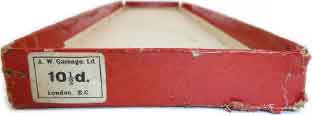
Picture 16: Gamage Price sticker
Usually placed on the end of the box, these stickers are an interesting addition to any box lid. They show that Gamages was offering one and a half pence off a shilling box of soldiers, a twelve and a half per cent discount. B
Several decisions had to be taken once the idea of toy soldiers was agreed upon. How would the models to be produced be designed? The answer for this was to get them, possibly off the shelf, in Germany, hence the first group of figures put on the market by the Britains, known as the Germanic figures, are rather different to the pieces designed by William Britain Junior which followed. To put a toe in the water, the Britains acquired six models in three varying sizes. Everything about them was devised to cut production costs while not compromising on quality.
First of all, there was a fixed-arm cavalry figure at the walk with a plumed helmet and tin sword, in 52mm scale. This Germanic Life Guard figure was to be used for the first three sets. Britains preferred to be able to mould each figure in one piece where possible, as hand soldering was costly and time consuming. The tin sword was added to the figure as a thin strip of tinplate of the right length, which could be inserted in the mould and used to represent the sword, rather than using a soldered part, as with most continental competitors. A version of this figure with separate soldered on reins recently came to light, both as Life Guards and Royal Horse Guards, that I have never previously seen. It could well be that Britains decided that the extra cost of the reins cut too deep into their profit margin, but this discovery holds out the possibility that there is an extremely rare pre-first version variation to be found if you are incredibly lucky!
Then there was a rather chubbier charging lancer, the Plug shoulder lancer. This figure was provided with a movable arm on a plug that fitted through the shoulders of the model. It was in much the same scale as the Life Guard. Also roughly in the same size was an infantryman of the line marching, with the rifle sloped on the right shoulder as would be normal in Germany. This little figure was first used for set 36, the Sussex Regiment, and is known as the Fixed arm valise pack figure. Slightly larger than these, about 54mm scale, was a running highlander, the Plug handed highlander. Finally, in 60mm scale, was a marching fusilier, the Plug handed fusilier, with the rifle sloped on the left shoulder as normal in Britain. For this set there was an accompanying mounted officer, which had a plug shoulder similar to the lancer. This mounted officer was also used to offer a set of Royal Scots Greys, and thus came to be known as the Plug shoulder Scots Grey. Whether just the master figures were commissioned from Germany, or whether the moulds were made there as well, they all have a distinct resemblance to contemporary German products, the fusilier in particular being almost identical to figures made then or subsequently in Germany.
Picture 17: The Germanic Group of figures
Germanic Life Guard (back centre) here painted as the officer of the 5th Dragoon Guards with gold sash, collar and helmet. In the earliest sets 3, only the officer had a painted gold (brass in real life) helmet, the other ranks helmets being left as bare metal. From 1894 this set had all gold helmets and an officer on the rearing horse.
The Plug Shoulder Lancer (back right) is the first of three variations of paint style and mould. Here in this 12th Lancer trumpeter, the lancer cap is left as bare metal, and there is no moulded cap line. Shortly after, the cap is painted black (in real life this is black leather), and in the third variation the cap is moulded with a cap line from the back base of the cap to the collar of the tunic.
The Germanic infantryman known as the Fixed arm valise pack figure (front right) is here painted in second grade as a Royal Marine Artilleryman. There has been some speculation as to whether the figure was issued in best quality for a first version of set 35, but I have never seen one, and as the set 36 figures of the Royal Sussex Regiment using this model are quite common, I am inclined to think not. The Plug handed highlander (front centre) was the only Germanic figure that was 54mm scale, and this may account for the long run of this figure in the catalogue until 1904. The figure illustrated here is the officer from set 15, who has a plug hand with sword. The painting of the kilt tartan is the unusual early style for the Argyll and Sutherland Highlanders: black with white stripes instead of the later dark green with light green stripes.
The Plug handed fusilier (front left) is larger than 54mm scale, and has a standard fusilier cap, also used for the mounted officer, which had a plug shoulder similar to the lancer.
The Plug shoulder Scots Grey (back left) was the same as the fusilier officer appropriately painted, which meant that the cap was inaccurate to real life, where the bearskin cap would have been considerably taller and bushier. The example here is of the trumpeter.
CONDITION All these six figures are G-F, except the Royal Marine, which is F-P. With rare early figures of this sort, it is quite normal to forgive a fair amount of paint missing, and they retain a great deal of charm. The lancer looks as though his horse has a crease in the metal at the base of the neck, perhaps from having had something heavy dropped on it. The Scots Grey has a front leg bent back, a common fault with this figure, probably from being dropped on a hard floor front leg down. Once there is as much paint missing as from the Royal Marine, and also because it is a second grade figure, the price for it might be no more than a few pounds. The other figures individually might well fetch between £100 and £300 each, the highlander and dragoon guard being less than the others. O
RARITY The Plug handed fusiliers and Plug shoulder Scots Greys are some of the rarest figures ever distributed by Britains, and very few survive – in boxed sets, they are a holy grail item. I have only ever seen one boxed set of fusiliers and have never seen a box for the Scots Greys. Two TOP 100 items. Boxed sets could easily exceed £5,000 at auction.
What was new about the Britains soldiers was that they were moulded hollow rather than solid, which saved both raw materials and transport cost, and enabled them to be sold in Britain at roughly half the price of German imports of a comparable size. Britains in later years credited themselves with the invention of the hollowcast figure, and there is really no way to prove it one way or the other. Several makers in Germany produced hollow toys by the same method, but they could have started later than Britains. Because the design of the figures was crucial to the process of pouring molten metal into the mould and then pouring the inner metal out again, I would incline to thinking that the process was already known. As the Britains family were astute enough to see the benefits of what must have been a relatively new method at the time, they were able to base their production on hollowcasting from the start.
There now follow listings of what I consider to be the significant sets, i.e. the sets that contain new figures or subjects. Some of the very early set numbers remain unknown, and for the First Age, which runs to 1899, the list is ordered by year. A brief idea of what every catalogue number contained, where known, is included. Further details on small size and second grade figures are in Chapter 2A.
For the early sets to set 197 (Chapters 1 and 2) the short description of the content of the set is followed by the number of versions e.g. 1V or up to 6V, and the last date at which the set was still in production. A U after the set denotes that the figures used for the set is unique to that set alone (if just for part of the set, the U is in brackets following the entry). Otherwise, the figures will have been used for other subjects, and will appear in Chapter 8. Set numbering was changed to a four-figure number in 1962 (given in brackets if relevant) but the date given includes production after that change.
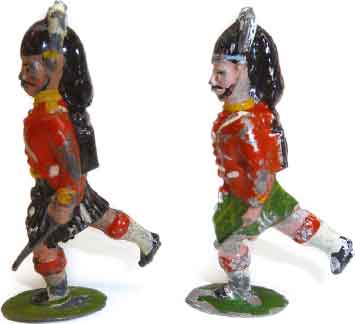
Picture 18: The Hanks plug handed highlander
Hanks Brothers produced the most annoyingly similar copies of Britains competitors, here with a figure painted as an Argyll and Sutherland highlander. The base is slightly smaller than the Britains, and the shape of the foot a little different, among other discrepancies. The sheathed bayonet of the Hanks figure is broken off. The metal from which Hanks figures were cast was slightly harder and brighter than Britains alloy, and the paint on the face was a distinctively pinker colour than Britains and most of their other competitors. The Britains figure to the left with which it is compared is an early black kilted highlander from set 15, similar to the officer in picture 17, but viewed from the other side. Both figures have lost their plug hands. B
1893, twelve significant known sets
The Germanic figures, with the exception of the smaller infantryman, were used to make the first production sets in 1893, as follows:
1. Life Guards, five mounted, one with a gold sash representing the officer, 6V-1966 (9205) TOP 100
2. Royal Horse Guards, similar, 6V-1966 (9209)
3. 5th Dragoon Guards, similar, 5V-1941
4. 12th Lancers, seven mounted with officer and trumpeter, 2V-1897 RARITY
5. 17th Lancers, similar, 2V-1897 RARITY
6. Royal Scots Greys, four of the fusilier officer figure, with officer and trumpeter 1V-1897 RARITY
7. Royal Fusiliers, eight fusiliers and a mounted officer, 5V-1941 1V-1897 RARITY
8. Number used for unknown set, or left blank, until 1896
9. Number used for unknown set, or left blank, until 1896
10. 16th Lancers, similar to set 4, 2V-1897 RARITY
11. Black Watch, six running highlanders and an officer, 4V-1966 TOP 100
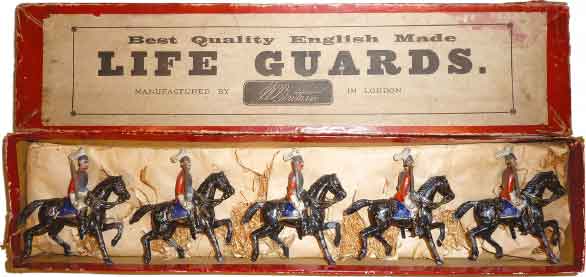
It would seem that while production of these sets was being set up, William Britain Junior had not been idle, since the figure used for the next two sets shows all the signs of being designed by him. This was a hussar slightly bigger and chunkier than the first Life Guard figure (See picture 21 below). Presumably once William Britain Junior had proved he could create masters to the right standard, there was no further need to source figures from Germany.
12. 11th Hussars, five mounted, 4V-1941 TOP 100
13. 3rd Hussars, similar, 4V-1941 TOP 100
14. Not known what would have fitted into the list at this point.
15. Argyll and Sutherland Highlanders, six running highlanders and an officer, 3V-1941 TOP 100
Pictures 19, 19A and 19B: Britains first set and box
A highly iconic set: the first ever set of Britains – this particular example must have been produced in 1893 or 1894, in all probability in the first year of production, first of all because the officer is not the one on the rearing horse which was added to the set in 1894. The officer is the figure with the gold sash, only easily visible when the figures are taken out of the box. Equally, the box itself has a packing of paper covered straw very similar to the contemporary German made sets. Very soon, this style of packing gave way to paper over card compartments in cavalry boxes.
CONDITION G-F, box F. Not very wonderful condition is easy to put to one side when a set is as significant as this one. Differences as opposed to later variations of the same model include rather slimmer tin swords on later figures, and the painting in of white cross belts over the cuirass.
A careful check of the paint style along the set reveals that the trooper in the centre of the box has much ruddier cheeks than the others, and a slightly different colour to what is left of the paint on the reins, as well as a different width, less rusted, tin sword. At some point it is likely that a different not matching figure found its way into this box. The price of this particular boxed set on resale will vary from the possible likely price at auction by the desire of the top collectors not only to own this box, but also to own a really nice and perfect example, where this one does not quite make the grade. On the other hand, it is the only example of the box I have ever seen!
The success of Britains first set in the first and second versions is evident, because the Germanic Life Guard can fairly often be found as an individual figure, even if in bad condition or repainted. Boxed sets in good condition are an altogether different matter. That it was a common style of design is evident from the solidcast Germanic Royal Horse Guards in picture 19B, which are probably made by Heinrich. Whether they predate or come after the Britains figures is entirely a matter for conjecture. Notice that the Heinrich figure is in the correct uniform with red collar, something that Britains did not get right for another forty plus years. 19, 19A O, 19B B
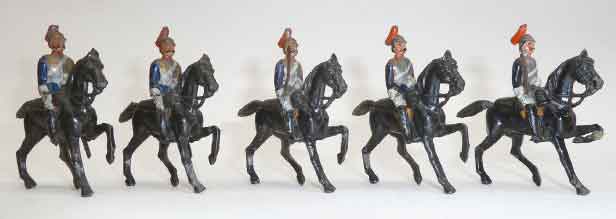
At this time the sets were not numbered on the boxes. The appearance of the first known publically numbered list was in a recently discovered leaflet from 1896. The following mystery numbers are those where the original sets allocated are speculative or unknown, some being filled at a later date by new sets: 6, 7, 8, 9, 14, 20, 26, 65, 70, 95, 103.
The small Germanic figure of a marching infantryman of the line was not used in this first year; indeed, it was not issued until 1895. This could have been because there wasn’t time to use it, or possibly it was acquired later to supplement the work of William Britain Junior, when expansion was the priority. It is even possible that it was the first marching foot figure that he designed himself, although it seems unlikely that he would have moulded the rifle on the ‘wrong’ shoulder. Such are the imponderables of the very early years of the firm.
Incidentally, although the Life Guard was the first of Britains regular range of toy soldiers, technically speaking it was not Britains very first toy soldier, since soldiers had been the subject of two of the toys that they had been producing previously: The General, a hobby horse style pushalong toy, and The Waltzers, a flywheel powered dancing toy in which one of the partners was a soldier. It is interesting to speculate which of these two might claim to be Britains first toy soldier, but we shall probably never know!
Initial Success for W. Britain and Sons, 1894, seven significant new sets
From the very start, the Britains family emphasised (as one might expect) their Britishness, with the slogan ‘Best Quality English Make’ heading every box label. The first boxes were very reminiscent of those put out by Heyde, in that they were red, and filled with a bed of straw topped with a paper lining to cushion the figures, which were then held in place by a layer of folded brown tissue paper. Boxed sets of five cavalry were priced at a shilling. The larger size sets of Scots Greys and Royal Fusiliers would cost a customer two shillings, and boxes of nine lancers came out at half a crown (two shillings and sixpence, or twelve and a half pence in decimal money). One reason why these sets were that much pricier was that the mounted figures had movable right arms which were attached to a plug which revolved within the shoulders of the figure. The fusiliers, and also the highlanders of sets 11 and 15, had hands holding weapons which plugged in at the wrist.
Judging from the surviving numbers of the more expensive boxes and the figures contained therein, sales were overwhelmingly of the shilling boxes. This is not to say that any of the sets sold in 1893 are other than extremely rare and difficult to find in their original boxes. One might even suppose that the success of the early days in 1893, which could after all have simply been a short Christmas season, was just enough to encourage the Britains to continue down the same path and try even harder.
In 1894, they came out with six new shilling boxes, at least two multi-row gift sets and a souvenir figure for the visit of the Emperor of Germany. Labels for the boxes became more ornate, and proper different figures were introduced as officers for the various regiments. The new sets were:
16. East Kent Regiment, officer and nine standing on guard, 4V-1941
17. Somerset Light Infantry, officer, four standing and five kneeling on guard, 5V-1966
18. Worcestershire Regiment, officer, four standing and five kneeling on guard, 4V-1941
19. West India Regiment, officer and nine marching, shoulder arms, 3V-1941 U
20. Could have referred to the Emperor of Germany souvenir figure RARITY
21. Multi-row display box containing 1, 12, 16 and 19
22. Multi-row display box containing 2, 11, 18 and 23
23. 5th Lancers, officer and four mounted at the halt, 3V-1931 TOP 100
24. 9th Lancers, similar, 4V-1966 TOP 100
Several of the sets 16, 17 and 18 would make up into an imposing formation of typical British infantry of the period in their red jackets and spiked helmets. Set 19, the West India Regiment, was the first set for which a unique figure was made, used in no other set.
Virtually all of the competing sets of soldiers arriving from overseas came with officers, colours and musicians, so the Britains wanted to include at least an officer to each set as quickly as possible. As the cavalry sets 1, 2, 3, 12 and 13 were currently without, William Britain Junior designed a superb figure of an officer on a rearing horse.
Another reason for the creation of this figure at this juncture may have been the visit to England of the Emperor of Germany, Wilhelm II (later known as Kaiser Bill) and his installation as Colonel-in-chief of the 1st Dragoons, the Royals. Ever since, the Royals have saluted with a Germanic click of the heels. In any event, this royal occasion enabled the Britains to sell the new cavalry officer as a souvenir figure of H.I.H. The Emperor of Germany, in an individual box, quite possibly as set 20, which would fit in with the numbering sequence. At what price it was sold has not been recorded, and I have only ever seen three examples. The figure is finished in silver gilt, a kind of dark bronze paint with gilded highlights, so might have commanded as much as sixpence.
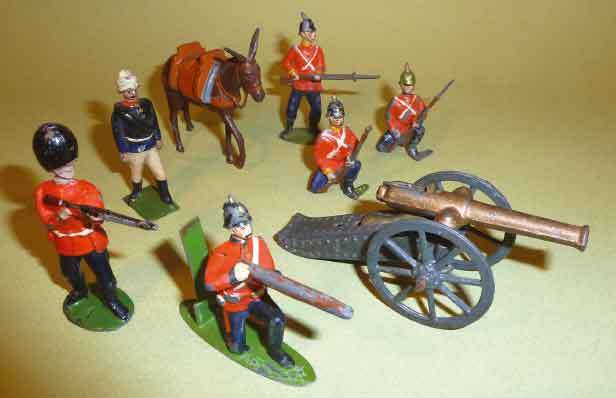
Picture 20: The first on guard figures, 1894, and various 1895 and 1896 issues
The first kneeling figures were on guard (top right). They had small stands attached to the left foot, which may well have served a dual purpose. Firstly they gave greater stability to the figure, but in addition they enabled the figure to be positioned in the cut slots in the bottom of the box to be held there while packed. The figure with the green helmet and blue facings is Somerset Light Infantry from set 17 (F), and the standing figure to his left is East Kent Regiment (the Buffs) from set 16 (G-F). in front of the standing figure is a kneeling figure with yellow facings (F) that could well be an East Kent Regiment figure from a larger assortment included in the very large display box 132, a box which is so rare I have never seen one. The bayonet is missing.
Britains first firing figure is the kneeling Soldier that will Shoot (F) in the foreground, the second being the ‘Volley firing’ figure to the left (G-F), which is a second grade painting example of the model initially issued in 1896 uniquely in set 34 (compare the paint style with that in picture 28 below). The man in the blue coat, the mule and the gun come from set 28, the Mountain Artillery. Here the artilleryman (G) is the second version from 1910, identical to the 1895 first version but with a rectangular base. The gun (G) took apart into barrel, trail and wheels, which could be carried on three of the mules. The mule (G) was Britains first separate animal. O
Picture 21: Kaiser Bill and the Officer on rearing horse
This magnificent mounted officer, a favourite among collectors, is known as the Rearing horse officer, Officer on rearing horse, or sometimes as the Prancing horse officer. The actual position of the model is much more rearing than prancing, but on the other hand the officer does not at all look as though the horse is trying to throw him off. It was created in the first instance in a form suitable for a Dragoon officer, complete with throat plume for the horse. It could well have been made specifically for the occasion of the German Emperor visiting London in 1894, but it was obviously a most useful addition to the range. In its guise as the iconic Britains first souvenir figure, I have only ever seen two other examples, and I was extremely lucky to obtain it with its lovely ‘printer’s decorated’ box lid for a modest price from a dealer at the British Model Soldier Society.
With the throat plume clipped off or excluded from the mould, the same figure would be easily painted as an officer for the Life Guards, Royal Horse Guards or 5th Dragoon Guards. By far the majority of surviving early sets 1, 2 and 3 with the Germanic figure come with one of these officers. Without the throat plume clipped off and with appropriate head changes, it did service in sets 31, 12, 13, and 83.
For later versions of the rearing horse officer, see pictures 44 and 45 below.
To the right of His Imperial Highness is a Donkey Horse Hussar. The gold crossbelt might indicate that this is a pre-rearing horse officer for set 13, 3rd Hussars. The red collar is an unusual incorrect detail for Britains, but a similar mistake was made with the Household Cavalry. In The Great Book of Britains, I illustrated the rather battered set from which this figure is taken as an example of a very early set 13, but now I look at the set again, the carbine butt is in metallic paint, which would indicate a date of 1900 or later, and two of the horses have black painted tails while the other three do not. The gold crossbelt does look a little amateur, and could be a later embellishment. It could be an amalgam of two sets from 1900 with three troopers and two officers missing!
To the right again are the second and third Britains models of lancers, used for sets 23, 24 and 33. The Lancer officer turned in the saddle is another classic early Britains figure, see text below. The one depicted is a 17th Lancer sometimes included in set 81, even though that set was of lancers in foreign service helmets. This makes it by far the least common of the lancer officers of this type, apart from special paintings.
The Cross legged lancer only lasted until 1903. This example is a 5th Lancer from set 23
CONDITION Hussar F, back leg of horse bent, the other figures G. The Cross legged lancer has lost the point of his lance, a common failing, and the plume and pennon have been touched up. O
One feature of better quality toy soldiers made on the continent was that heads plugged in to bodies, so that changes of headgear were very easily made. Britains individual figures had no plug in heads, the head being normally included in the two-piece mould. By making a three-piece mould, however, they could achieve the same effect as a plug system. To change headgear, they devised a separate piece of the mould for the head, which could be changed when necessary. The first of these was applied to the rearing officer, a hussar officer’s head that would enable the mould to produce officers for sets 12 and 13.
Sometimes there was an obvious reason why Britains made a particular model. As far as the West India Regiment was concerned, the official reason has been lost, but apparently the regiment had been much in the news in the third Ashanti war, so this might well be the first instance of Britains making a set to reproduce current military events. The toy soldiers, in their distinctive Zouave uniform, are a real treat, the first of many units from the far-flung British Empire.
The four-row display sets 21 and 22 were evidently created for the Christmas market, and showed no concession to bulk purchase, having a four-shilling price tag. Between the two of them they offered the contents of eight out of the thirteen boxes so far available priced at one shilling. In spite of the fact that these combination sets are not significant, as they simply bring together previously issued sets, they are far rarer than their single set components, and so, particularly in their very early versions, as here, can command extremely high prices. Of course, possessing one of these two sets would mean that one did not have to collect any of the individual sets concerned.
The advent of the new sets 23 and 24, lancers at the halt, with sets 4, 5 and 10 completed the roll call of contemporary lancer regiments in the British Army. It also introduced two further classic figures, the so called Cross-legged lancer, from the positioning of the horse’s rear legs, and the Officer turned in the saddle, which was if anything an even finer model than the rearing officer. This lancer officer has the distinction of being the first and only model to survive all the modelling updates visited on its contemporaries and still be in production at the end of hollowcasting in 1966. The pose is of an officer reviewing his halted squadron by turning his whole body to the right, with one hand holding his tin sword. The figure is often used as an icon of excellence for Britains, and was later (1958-9) on sale in an individual box as set 2169.
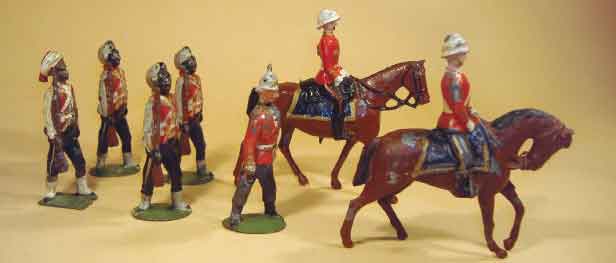
Picture 22: Set 19 West India Regiment
On the right is the mounted officer for the West India Regiment (F), a differently painted uniform of the ‘Head down spindly horse’ from the Mountain Artillery officer for whom the model was initially created. The head on this officer has a rather fatter helmet than the more common head. Behind is the second version (G), the ‘Head up spindly horse of 1910. The ‘Spindly’ horses were widely used for second grade cavalry sets. The marching officer (F-P) is the one originally used for set 19, just for the first year of production. He is exactly the same ‘Bemedalled’ fixed arm officer as was supplied for set 17. Next to the left are three first version men from set 19 (G-F), with oval bases. This figure was one of the last to be changed to a rectangular base, which happened around 1925. The figure on the extreme left is such a second version, with its appearance completely changed by the substitution of a model head and some repainting, thus becoming an interesting conversion. Because his condition is only Good to Fair (G-F), he might easily be taken for a copy of a Britains by another maker. O
By the end of 1894 it seemed that toy soldiers definitely had a future, and the Britains had big plans for them. 1895 would see the arrival or expectations for Soldiers that will shoot, mountain and Royal Horse artillery, military bands, more cavalry and more infantry, including the first appearance of the Foot Guards. After that, in 1897, would come the huge pageantry event of Queen Victoria’s diamond jubilee.
The Competition from Germany
German toy soldier manufacturers who had previously had the British toy soldier market pretty much to themselves were not slow to notice Britains new products. The main response appears to have been three-fold. Heinrich in particular tried to counter Britains hollowcast figures with very similar hollowcast models of their own, sold in very much the same sorts of sets and boxes. A figure almost identical to the Rocking horse was fairly widespread in the UK market, depicting a number of regiments of cavalry and colonial troops. The only evidence as to how successful Britains were at fighting off this competition is in how many of these Heinrich figures still exist, and this shows that Britains were overwhelmingly successful, outselling Heinrich by at least a hundred to one. Britains used mass production, standardised lines, keen pricing and patriotic marketing to sweep the board, and their victory must have been very quick. German made hollowcast figures are not unknown, and quite varied, but they are a great deal rarer than Ancient Britains.
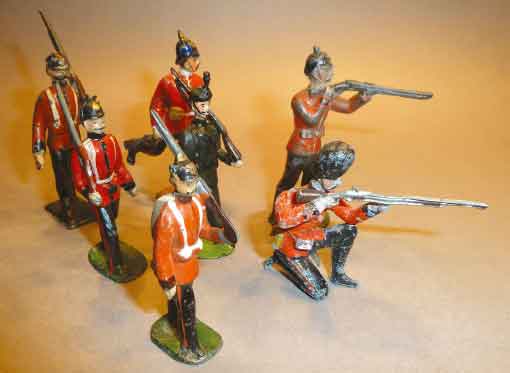
Picture 23: German hollowcast figures
Whether before 1893 or (more likely) afterwards, the German manufacturers such as Heinrich in particular were not going to give up their British market just because of a new process. Here is a selection of the German made British infantry on offer, surrounding a contemporary Britains valise pack rifleman for size comparison. Judging by the difficulty of finding these hollowcast German figures today, they were not successful in stopping Britains from sweeping the board. Mostly, these German figures turn up in appalling condition, and can often be badly oxidised, such as the fusilier on the right. The tall infantryman on the left has lost his helmet spike. As the British helmet was copied from that used by the Prussian army, very often figures with the rifle on the left shoulder are simply Prussian infantry repainted as British by the manufacturer. O
Picture 24: Heinrich and other full gallop sets
Although the cavalry in this picture are on Rocking horses that look more or less identical, only four of them are Britains. The front row are all Britains, from set 83 and 43, and the fixed arm 6th Dragoon Guard probably from an X series set (note the way that the face has spread rather sloppily over the helmet). The second row is all Heinrich, made in Germany. The third row, with the exception of the Britains Royal Horse Guard from set 93, is all Hanks.
Regiments depicted are, front to back, front row: Middlesex Yeomanry, 2nd Life Guards, 6th Dragoon Guards, second row: 2nd Life Guards, Royal Horse Guards, 1st Dragoon Guards, 16th Lancers, Royal Scots Greys, 3rd Hussars, 7th Hussars, back row: Royal Horse Guards, 1st Dragoons, 2nd Life Guards, 4th Hussars, 13th Hussars and 7th Hussars. O
Another way in which Heyde in particular responded was to use their smaller no.2 size figures of about 48mm scale, and to emphasise the variety in which they were available, thus concentrating in the British market on selling soldiers that Britains did not produce, such as Romans, Knights and other favourites of Victorian fantasy, as well as matching Britains shilling price through using the cheaper size. It is quite possible that this form of competition led Britains to start their own small size range in 1896, with its basic sets at sixpence (see Chapter 2A).
The German companies also emphasised the quality and variety of their products by producing beautiful and expensive larger sized figures, as well as huge presentation boxes of everything from the Fall of Troy to Queen Victoria’s Diamond Jubilee
As was inevitable, the moment that other people started to work for the Britains family producing toy soldiers, the expertise needed for hollowcast production became known to potential domestic competitors. It is not known how soon the first of these started, but it had certainly grown into a serious problem for Britains by 1900, and Britains took very active countermeasures in the Second Age.
Building on a good start, 1895, ten significant new sets
Based on their previous experience with mechanical toys, the Britains family seem to have had several ideas up their sleeves for extra play value with toy soldiers.
25. Soldiers that will Shoot, four kneeling firing, leaf springs behind shoulder 1V-1916 U TOP 100
Maybe this was an early Britains idea for toy soldiers, as the patent for them is dated 1893, so developed before then. Could this have been the mechanical toy that started the whole thing off ? Heyde and other German figures were available with firing mechanisms, although usually in larger scales. One almost identical German model in an American uniform has recently come to light. Was this produced for sale in America by a German firm on the basis that the Britains patent did not cover America? Action toy soldiers of this sort have always been a recurrent theme. Britains were traditionally a firm making toys with automated movements of various sorts. If the number they received in the catalogue was anything to go by, these were first issued in 1895. They are an expensive favourite among collectors, given their probable significance.
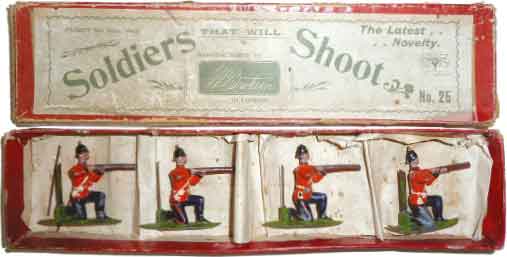
Pictures 25 and 25A: Soldiers that will Shoot
Boxed sets 25, Soldiers that will Shoot, are one of the rarest and most expensive of all Britains sets, and in good condition can fetch upwards of £2,000. This one is not in such good condition, with a box that is Fair to Poor and figures that are only Fair. The figure on the right has a bent base, and the next one to the left has a helmet spike missing, and a very small hole in the belt pouch. The box is compartmented as in a cavalry box, and there is an extra folded compartment in the centre to take the wire ammunition, one piece of which can be seen in the left of the box. Other examples of the ammunition I have seen have been rather shorter than this. The competitor figures in US uniform are in Poor condition, but they are the only examples I have ever seen. The springs are missing, and two of the helmet spikes, the other one being badly bent over. It is a matter of conjecture as whether the gun barrels were ever similar to the Britains ones, or started out life in this truncated form, which might well have been better for the firing action, as there would have been less friction to slow the exit of the missile from the gun barrel. B
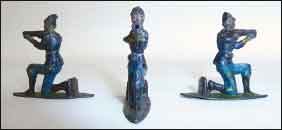
26. The set that was first issued under this number is unknown
27. Band of the Line, a twelve piece set not ready for issue until 1896, 6V-1955
28. Mountain Artillery, six men, four mules, gun and mounted officer, U 4V-1966
29. Large four row display box, containing 1, 13, 24, 28 and fifteen pieces of the Royal West Surrey Regiment
30. Drums & Bugles of The Line, 5V-1966
The first four musicians were fixed arm and provided an eight-piece drums and bugles band with blue facings, for a royal regiment. It contained a drum major and bass drummer, two side drummers and four boy buglers. Britains had meant to precede this with set 27, the Band of the Line, but evidently they had not finished all the complex modelling of the five different instrument arms which were to slot in at the shoulders of the musicians. Set 37, the forthcoming full band of the Coldstream Guards, involved making a further three instruments. The Band of the Line would have white facings and a blue bass drum as opposed to the bugle band’s brown one. Drummers and/or buglers were now included in sets 16, 17 18 and 29 with appropriate facing colours.
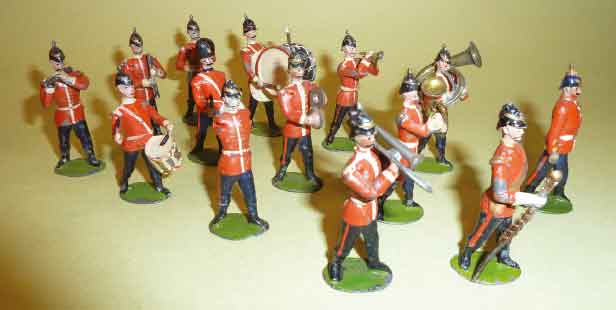
Picture 26: Musicians
These are predominantly ‘Slotted arm’ musicians from set 27. In the second row of the band is a musician without instrument, to show the slots into which the arms were fixed by using a little solder. In front as they are marching is a ‘Bemedalled’ officer from set 16 or 29, standing in as a musical director. Set 27 was to comprise the drum major (F), two trombonists, two musicians with euphoniums, three with cornets, one with cymbals and one with fife, as well as a bass drummer and side drummer. The band was given white facings, and set 30, the Drums and Bugles, had blue facings, with the bass drum being painted brown rather than blue. The only figure that was indistinguishable between the two was the drum major. There were three distinct heads that can be seen here that the bandsmen might be fitted with, not normally mixed within sets. In display set 73, there was a fourteen-piece band of the line that included a bombardon (F), two clarinets (G) and a bassoon, at the cost of discarding one cornet (F) and one euphonium. The new instruments were made for set 37, the Coldstream Guards band, and their inclusion in set 73 accounts for most of the occasions on which infantry of the line bandsmen are found with these instruments. This picture includes all the instruments, although the top part of the bassoon (back row right) is missing. In the third row of the band are two side drummers. The drummer on the left is the second version ‘Heel and toe side drummer’. The drummer to the right is a converted recast first version figure made to look like a fusilier. This is known as the ‘Pigeon-toed drummer’ from the wide angle of the back foot. Most Britains foot figures of the early period have the right foot pointing out to the right like this, as can be seen in this picture, but the Heel and toe drummer, introduced about 1899, had the back foot straighter and up on its toes. For illustrations of the buglers used in set 30, see Chapter 8 under Bandsmen. CONDITION: most of the figures here are in Good to Fair condition, except as indicated in brackets above. The drum major and the man without an instrument have lost their helmet spikes and the second version side drummer has a somewhat bent drumstick. O
31. 1st Dragoons, officer on rearing horse and four mounted at the walk, 4V-1941
32. 2nd Dragoons, Royal Scots Greys, officer same as troopers, 5V-1966
A new standard size fixed arm walking horse with a tin sword was designed for these two dragoon regiments in full dress. An interesting variation on this first version was the provision of foot guard headgear to some sets. Whether the heads for set 34 were ready and used, and then modified when complaints came in, or there was some other reason, is not known. In the larger size Scots Greys probably designated originally as set 6, the horsemen had a fusilier cap, using the mounted officer of the plug-handed fusiliers without modification. As far as toy soldiers went, the caps of the fusiliers and the bearskins of the foot guards and Scots Greys were all too alike. At the age of six, I found them indistinguishable and so had bought for me in Harrods my first box of best quality Britains, a Royal Welch Fusilier set 74, mistaking them for foot guards.
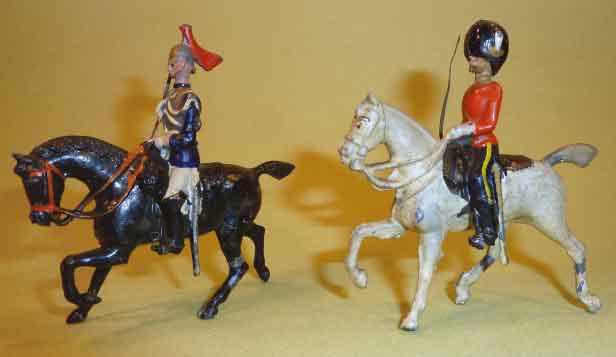
Picture 27: Tin Sword Royal Horse Guard and Scots Grey
These are the only figures with fixed arms and tin swords that replaced other figures during the first age. The Royal Horse Guard came out in 1897 in time for Queen Victoria’s Diamond Jubilee. Note the prominent aiguillettes (indicating a corporal of horse) moulded onto the chest of the figure. The Scots Grey became set 32, here with a foot guard head, which is possibly a first variation of it. O
33. 16th Lancers, same composition as sets 23 and 24, 4V-1952 TOP 100
34. Grenadier Guards, eight firing with drummer and officer, 5V-1941 U
This was Britains first set of foot guards, issued in their first version with the unique Volley firing foot guard, used in best quality in no other single row set. It is to me rather curious that they chose not to represent the Foot Guards until their 34th set, and at that they were in a combat position. Although the guards band followed on closely, no marching guardsman came out until the movable arm valise pack Scots Guard in set 75, a year later. It must have been the rush to get so many things done all at once.
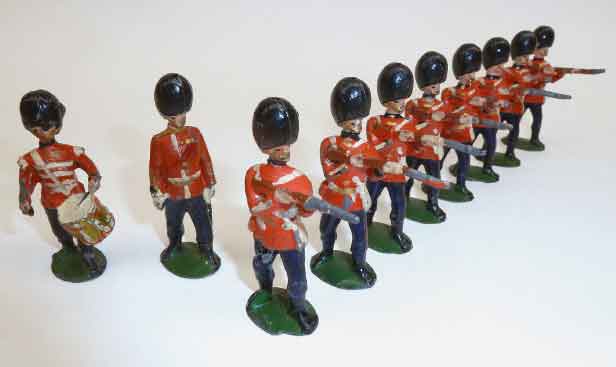
Picture 28: Set 34, Grenadier Guards
This set must come from around 1898, as the box (not shown) has the set number on the label. Maybe Britains were becoming so popular that they had hired some rather bad painters, because I can’t see the quality control letting this one through unless they were desperate. In spite of this, the result is in its way charming, and in this set the chins have been liberally splashed with chinstraps. Two of the firing rifles have been broken off, but the one nearest the camera is not broken, just a casting fault in which the metal has not run to the end of the mould. The green of the bases is at the darker end of what would be normal for Britains. B
35. Royal Marine Artillery. Logically nine fixed arm men with bemedalled officer, but never seen as such, so possibly never issued. Likely not to have been issued until 1897, as a movable arm valise pack figure.
36. Royal Sussex Regiment, eight fixed arm men with mounted officer, 3V-1941 TOP 100
Was the marching man with the rifle on the right shoulder, known as the Fixed arm valise pack figure, a German design? It was apparently first used for the Royal Sussex Regiment in set 36. It has full trousers as opposed to the gaiters worn by all other Britains troops on foot in this period. Carrying the rifle on the right shoulder was something favoured by German toy makers. In other words, he is a bit of an oddity. In his favour, he fits very well both with the bemedalled officer or with the spindly horse mounted officer provided in the set. Then there is the mystery of why he turns up reasonably frequently as a Royal Sussex, or even as a West Surrey from set 29, but never in best quality paint as a Royal Marine Artilleryman from set 35, only as a second grade version.
1896, seventeen significant new sets
37. Full Band of the Coldstream Guards, twenty-one musicians, 7V-1959 TOP 100
27. Band of the Line, twelve musicians, 6V-1955
38. Dr Jameson and the African Mounted Infantry, 3V-1941 TOP 100, V1 RARITY
The Dr Jameson set was Britains second stab at something topical (the first having been for the visit of the German Emperor Wilhelm II, Queen Victoria’s nephew, in 1894). Character figure – Dr Jameson. The boxed set that names Dr Jameson on the label is extremely rare.
39. Royal Horse Artillery, 5V-1965
Requiring a huge amount of work to produce the six horse team, gun, limber, bucket seats and mounted officer, this set retailed at 6/-, but certainly felt like six times the value of a single row box. This set, and particularly the first version, which lasted only until 1906, has been a huge favourite among collectors ever since, often changing hands for over £1,000. It would be in the TOP 100, except that the set 73 in the TOP 100 contained one, and so no extra one on its own needs to be collected.
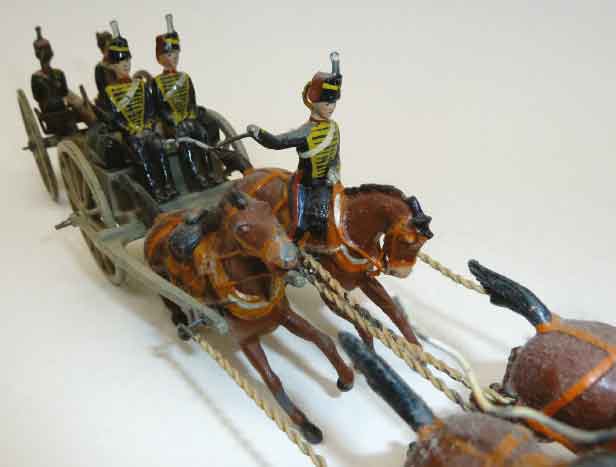
Picture 29: Royal Horse Artillery retouched
In this close up of a gun team from set 39, everything looks original except some added white paint on the whip of the second driver, visible in the foreground. However, the faces of the third driver and the seated gunners have no moustaches but red mouths, where normally they should have moustaches and no mouth would be seen at this period. Does this look original? The cheeks seem quite broadly painted, so this could mean repainted faces. The red of the busby bags, collars and trouser stripes looks rather too dark to be genuine. CONDITION G, in spite of a good bit of paint missing from the upper whip arm and shoulder of the third driver, and the nose of the offside horse. It could be tempting to categorise G-F. B
40-42. Two row British Army display sets
43. 2nd Life Guards, trumpeter and four troopers with carbines, 3V-1941
44. 2nd Dragoon Guards, trumpeter and four troopers with lances, 3V-1952
8. 4th Hussars, trumpeter and four troopers with swords, 3V-1952 TOP 100
The latest three sets introduced the new horse outstretched at full gallop with a brand new feature, the stud and loop type movable arm that was to be typical of most Britains hollowcast toy soldiers. The entirely unrealistic position for the new horse has always been beloved of toy soldier makers. Britains collectors have nicknamed it the rocking horse, as it would fit so well on rockers. For the first time, regular shilling sets included trumpeters rather than officers. Trumpeters had of course featured in the early Scots Grey set, and the three sets of lancers featuring the slightly smaller but similarly positioned Germanic horse at the full gallop. The 4th Hussars filled in an earlier catalogue number that had fallen vacant.
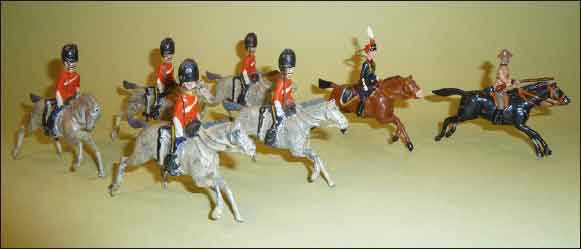
Picture 30: RHA type Scots Greys
The galloping RHA officer from set 39 and the Jameson figures from set 38 look remarkably similar, but which was derived from the other is unknown. These are splendid fixed arm models quite different from anything seen previously. I do not know whether the set of Scots Greys was made by Britains or a competitor, but I have never seen another set like it. The figure on the far left has had the horse’s head replaced. O

Picture 31: Rocking horse to Swayback, movable arms
The Rocking horse Middlesex Yeoman is front right CONDITION F-P. So much paint has gone that it is only acceptable as a sample of a famous early figure, though even now it has a great deal of charm. The Indian cavalry figure is from set 47, 1st Bengal Cavalry. Britains may have been misled as to the uniform colour of Skinners Horse by the source material they used, a watercolour that was discoloured from yellow to ochre by its journey from India. This would not explain the incorrect turban, however. This figure is of much later date, with a thin late 1920s pattern sword, rather than the thick straight sword supplied with the original models. The camel used in set 48 later featured with the British rider shown here as in Britains largest set, number 131. The end of the rifle is missing in this example. The Indian Infantryman is from set 67, 1st Madras Native Infantry CONDITION F. In the first two versions a pioneer was supplied as well as an officer. The General on the Swayback horse was issued to command set 73. O
I should not neglect to point out that even at this early date, adult Britains collectors were a recognisable feature of the market. In an article in the March 1896 issue of Athletic Sports, Games and Toys, it states ‘we remember Mr Alfred Britain telling us that many gentlemen make a point of buying every new set in the unique series which his firm are producing, and that they value them for their perfect modelling and correct colouring’. Where, I wonder, have these collections ended up today!
Bringing the Jubilee
Britains were now focussing much of their attention on the year of Queen Victoria’s Diamond Jubilee, set fair to be a milestone celebration of the glory of the British Empire. Pulling out all the marketing stops, they added another thirty-nine sets to their list by the end of the jubilee year, virtually doubling their range and coming up with the further initiatives of their first massive two tier display box and a whole new range of small size figures. The troops of the Indian Empire and the Royal Navy featured for the first time.
45. 3rd Madras Light Cavalry, trumpeter and four troopers with swords, 2V-1941
46. 10th Bengal Lancers, trumpeter and four troopers with lances, 2V-1941
47. 1st Bengal Cavalry, trumpeter and four troopers with swords, 4V-1966
48. Egyptian Camel Corps, six troopers on camels, 3V-1966
49. South Australian Lancers, officer and four troopers with lances, 4V-1941 TOP 100 50-56. Two and three row display boxes
57-58. Small size display boxes (see chapter 2A)
59. Two row box of Scots Greys
60-63. Two and three row boxes of Indian Army Cavalry
64. 2nd Madras Lancers and 7th Bengal Infantry two row box, 3V-1941 TOP 100
65. The set that was first issued in this slot is unknown
66. 1st Bombay Lancers, trumpeter and four troopers with lances
67. 1st Madras Native Infantry, officer, pioneer and six men, 3V-1941
68. 2nd Bombay Native Infantry, similar, 3V-1941
69. Pipers of the Scots Guards, 6V-1941
All of the above twenty-five sets were issued in 1896. The eleven Indian Army sets and displays were based on just one each new cavalry and infantry figures, each of which were given movable arms. The early single row cavalry sets had a native officer with sword arm outstretched, but a couple of years later the trumpeter also included in the double and triple sets was substituted, perhaps on the grounds that only the larger sets needed an officer. The troopers had either swords or lances. In the double and triple row boxes there would also be the officer, thus giving an additional incentive to buy a larger box. The infantry sets from 1897 included a pioneer as well as an officer, the pioneer axe having arrived with set 82 (see below). The double row box 64 contained two regiments not available in single row boxes, which proved a popular innovation.
In among all the Indian Army and repeats of British Army units in display boxes were three notable newcomers, the South Australian Lancers, Egyptian Camel Corps and Pipers of the Scots Guards. The first two swiftly became feature favourites, and have remained so with collectors. Making the piper figure meant that potentially all the highland regiments could also benefit, which, with the curious exceptions of the Black Watch and Argylls, they duly did.
1897, fourteen significant new sets
70. What was to be issued here remains a mystery – possibly a set of Greeks to oppose the Turks
71. Turkish Cavalry, officer and four men with lances on the Indian cavalry horse 2V-1941 TOP 100
The Greco-Turkish War of 1897 was the obvious reason for Britains to issue a box of Turkish cavalry at this point, named on the box the Ertogrul Regiment. If there were to be Greeks, they never made it to the market place, possibly because they were not so easy to create from existing moulds as the Turks, who were just the Indian Army cavalry figure with the head with fez from the Egyptian Camel Corps. Whatever the inside story here, the Turks were Britains first non-colonial foreign troops, brought out in response to historical events.
72. Life Guards 1837 and 1897, Queen Victoria’s Diamond Jubilee souvenir set 2V-1916 TOP 100
A new Life Guard with tin sword was designed for this set to replace the original Germanic figure, and very nice it was too, properly complementing the superb officer on the rearing horse. Although it also became the standard figure for set 2, the Royal Horse Guards, examples of this version of set 3, the 5th Dragoon Guards are incredibly rare, leading to the supposition that there was a large stock of Germanic castings which were gradually used up entirely for set 3, or maybe the moulds were continued in use solely for that set. This might lead to the suspicion that the 1897 Life Guard casting was never used for set 3, even though a few very convincing sets and figures have been discovered. The jury is still out.
73. Large two-tier display set, 78 pieces, 25/-. The longest lived display set, current to 1965 TOP 100
9. Rifle Brigade, officer and seven men at the slope, replaced the original set 9, 3V-1922 TOP 100
74. Royal Welch Fusiliers, similar but with goat mascot (U) to make 9 pieces, 5V-1966 U A TOP 100
75. Scots Guards, officer, piper and six men at the slope, 5V-1966 TOP 100
76. Middlesex Regiment, officer, pioneer and six men at the slope, 6V-1963 TOP 100
35. Royal Marine Artillery. Not issued until 1897 as movable arm valise pack, 7V-1966
The year of the Diamond Jubilee brought the new Valise pack marching figure and the Wasp-waisted officer that were the basic models for these latter four new sets, joined by a new issue of set 7 to replace the old large plug-handed fusilier set. This had evidently been unpopular enough to need selling off at a shilling rather than the initial premium two shilling price.
77. Gordon Highlanders, officer, two pipers and four running, 4V-1966
Picture 32: Valise packs Piper to Goat – sets 69-76
There is a bemedalled foot guard officer on the left, to show how large the bearskin was in contrast to the fusilier cap. The trousers of this officer and the second last figure on the right show how the high varnish content of the paint sometimes allowed bright metal to shine through dark blues. The Royal Welch Fusilier goat mascot is the third animal other than a horse to be made by Britains, after the mule included in set 28 and the camel in set 48. The bemedalled fusilier officer is followed by the movable arm Wasp waisted officer, and two examples of the new valise pack marching figure with loose sling flat rifle. This figure could be fitted with different heads, and there appear to be two quite distinct heads in use here, the one on the right being larger. The different style of rifle painting changes from the earlier matt brown to a metallic brown, and the man on the right is no longer wearing white gloves. These marching figures are all just 52mm tall, so rather smaller than later Britains figures. O
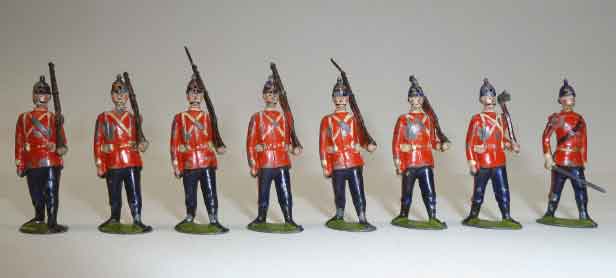
Picture 33: Middlesex Regiment 1st Version * ‘Valise Pack’
This early set 76 is distinguished from later versions by the white facings, inclusion of a pioneer, the valise packs and wasp waisted officer. CONDITION F, almost F-P, with a good few scrapes and dents to the paint as well as four missing bayonets. For those without such an early set, however, this is still a very acceptable addition to a collection at a reasonable price. A VG-G condition intact set would be worth £300. This one would sell for around £100. B
Picture 34: set 77 Gordons with pipers
A very nice set of plug handed highlanders provided with two of the pipers from set 69, appropriately painted. CONDITION VG-G. Early pipers were for some reason painted as redheads, with red-haired eyebrows and moustaches as with the one on the left here, the piper on the right has no eyebrows at all and various other paint details different from the other piper. One has to be not original to this set – my guess would be the one on the left, as the tartan stripes on that figure are very thin compared to the running figures. Although not matching, the red hair may well mean that it is earlier than the rest, say 1897 as opposed to 1900. B
78. Royal Navy Bluejackets, petty officer with seven running at the trail, 3V-1941
79. Royal Navy Landing Party, petty officer with eight men, limber and gun, 3V-1966 U
80. Royal Navy Whitejackets, petty officer with seven running at the slope, 3V-1941
81. 17th Lancers, Ulundi, officer, trumpeter and three troopers with lances, 4V-1941 TOP 100
82. Scots Guards Colours and Pioneers, colour bearer and seven pioneers, 5V-1959
These remaining 1897 sets introduced the Royal Navy, the first British regiment, the 17th Lancers, in overseas service dress, and the first colour bearer in a single row set (there was a Royal Welch Fusilier colour bearer in set 73).
I suspect that the Britains family were exhausted at the end of 1897 – perhaps their extremely ambitious programme of expansion had resulted in too many unfulfilled orders, and plenty of competitors starting up. Whatever was going on, a couple of years of consolidation and re-thinking seemed to be in order. During what was a bit of a tidy-up, box labels received catalogue numbers and anti-competitive strategies were devised, as well as the small size and cheap series being increased. This is all conjecture based on Inherent Commercial Probability, but there were relatively few new issues in the standard range for 1898-9 compared to 1896-7.
At this point, too, the tradition of eight movable arm foot figures and five mounted to the shilling box was firmly established as the norm, with an extra two foot figures (or one mounted officer) for fixed arm figure boxes. There were, and would be, plenty of exceptions based on extra work, for instance for highlanders, being included in the sets, but the norm was established. Box sizes became standardised around these numbers, and the packaging within the boxes was five paper covered card compartments for cavalry, and eight or ten slots in the lower edge of the tray to take the oval bases of the infantry. The soldiers were held into the box by wads of brown tissue paper, individual for each compartment for the cavalry, and a concertinaed wad the whole length of the box for the infantry.
83. Middlesex Yeomanry 3V-1941 TOP 100
This set was the first non-regular army regiment of the British forces issued by Britains, and also featured the use of three different figures rather than one or two, as it contained an officer on a rearing horse, two donkey horse hussars and two on rocking horses. The result was one of the prettiest sets yet produced, one of my all time favourites, a view I think shared by many others.
84-87. Small size display sets (See chapter 2A)
88. Two row display set Seaforth Highlanders, officer, two pipers and eleven running men 4V-1941
89-90. Not issued until 1901, when Britains had finalised their scheme for copyrighting figures
91. US Infantry, officer and seven men at the slope, 2V-1941 TOP 100
92. Spanish Infantry, officer and seven men at the slope, trail or mixed, 2V-1941 TOP 100
The US and Spanish Infantry were topical releases during the Cuban war. Both were based on the Valise pack figure, and both count for the TOP 100. RARITY Some extraordinarily rare sets of the US Infantry were issued in white spiked helmets.
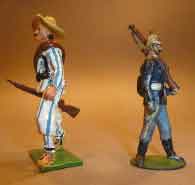
Picture 35: US Infantryman in white helmet
Poles apart. To the right, a rare, possibly first, version of set 91, a valise pack marching figure in a white infantry helmet. I acquired this from the Ruby family collection. It is a typical example of a figure that is in Fair to Poor condition, but well worth having because there may only be one complete set in circulation, the one formerly in the Ruby Family collection from which this was an extra piece. Contrasted to the left is a Cuban Spanish soldier from the Britains Centenary set 8899, issued a hundred years later. The comparison speaks for itself. O
93. Two-tier display set, tier of Coldstream Guards, tier of Royal Horse Guards, 71 pieces TOP 100
94. 21st Lancers, Omdurman, officer and four troopers, lances, in khaki, 4V-1941 TOP 100
95. The set that was first issued in this slot is unknown
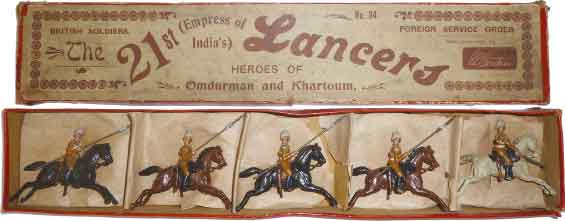
Picture 36: Early boxed set 94
The first version of set 94 was on the Rocking horse. Note the early lance arms, blue puttees, white helmets and compartmented box. Compare with the second version in picture 84. B
96. York and Lancaster Regiment, officer and seven men running, 5V-1941 TOP 100
97. Royal Marine Light Infantry, similar, 7V-1941 TOP 100
98. King’s Royal Rifle Corps, similar, 6V-1952 TOP 100
The battle of Omdurman took place on 2 September 1898, and Britains were quickly out with a participating regiment (but no opposing forces). The York and Lancaster Regiment had made its name in the near disaster at the battle of Tamai in 1884, the first Sudanese campaign. The new Pigeon-chested running figure was used for two other single row sets and was also introduced as a row in the large display box 93, which had previously contained all marching Coldstreams.
RARITY Unusually, the three running sets 96, 97 and 98 all share the distinction of changing their standard uniform very quickly after they were first issued. Probably by 1903, the York and Lancaster Regiment had changed out of Omdurman service dress into full dress, the Royal Marine Light Infantry changed from a white spiked helmet to a blue one, and the King’s Royal Rifle Corps changed from a spiked helmet into the normal full dress rifles busby. For this reason first versions of these sets are rare and desired by collectors.
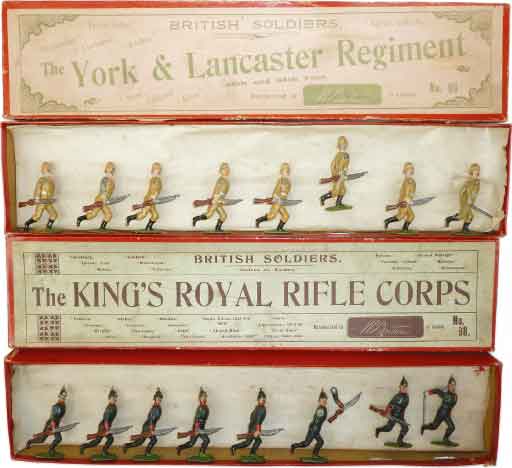
Picture 37: Running Infantry
The TOP 100 ‘pigeon chested’ sets 96 and 98 are two of the prettiest ‘Ancient Britains’ sets that any Britains collector could hope to acquire. These two are in really old printers decorated boxes, probably actually made in 1899, with the oval bases of the figures tucked into individual slits cut in the lower edge of the box. A pleat of brown tissue paper would have filled the rest of the box, as it does under the backing paper, which is still intact. The only thing wrong here is that a stud has come off one of the riflemen, so that the movable arm will no longer attach to the shoulder. B
99. 13th Hussars, trumpeter and four troopers with swords, 3V-1941 TOP 100
100. 21st Lancers, full dress, similar, with lances, 3V-1941 TOP 100
These two sets came out on the new Pony horse, a smallish but very attractive trotting figure, quite similar to the Life Guard horse of 1897 but with a movable arm. This had a slight variation in the casting, showing the horse with or without its ears pricked. Britains experimented with trying out some previous cavalry sets with the new horse, leading to some very short-lived variants with few examples issued. Only set 81 moved permanently to the new horse as a regular version.

Picture 38: Pony Horses and the new running figure
The set 81 17th Lancer trumpeter to the right has a pony horse with pricked ears, the lancer to the left has no pricked ears to the horse. The lancer has the very early arm with lance, with the pennon and lance head often, as here, somewhat miscast. The lance head is more conical than the later version of lance head, which has a shorter bulge in the middle. Here it is crying out to be carefully bent straight. Note the yellow stripe to the trousers of the trumpeter, usually, and true to real life, painted in white. Both 17th Lancers CONDITION G, nearly G-F. The running figure is a pigeon-chested York and Lancaster Regiment man running, from the first version of set 96, CONDITION G-F. O
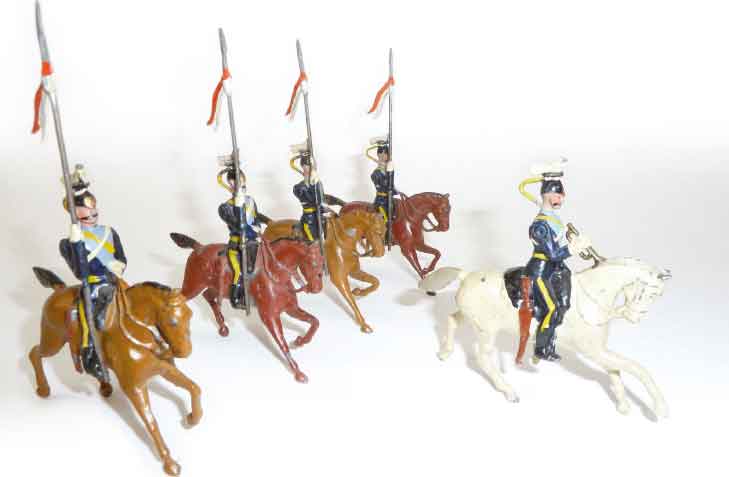
Picture 39: 21st Lancers on Pony Horses
This rare set contains troopers on prick-eared pony horses, but with a trumpeter on the brand new cantering horse dated 12.2.1903. It is highly likely, therefore, to have been issued very close to that date, before the troopers also appeared on the cantering horse. B
Picture 39A: Contemporary competition for Britains, 1900: Hanks Royal Dragoons, set 117
Hanks were quick to copy Britains latest ‘Pony horse’ from 1899, including both a trumpeter and an officer in the set, all on the same horse.The label was evidently designed for a shorter box, as the end designed to bend round onto the end of the box does not reach to where it was intended to be. Although the box cover paper is pale blue rather than red, the label is made up at the printers in exactly the same way as many Britains labels. B
The Pony horse was much copied by Britains competitors, which fact may have been the final straw for Britains, leading them to take legal action to protect their models at the start of the Second Age.
101. Mounted Band of the Life Guards, 12 musicians, 5V-1965 TOP 100
Coming to the break point for the end of the First Age of Britains, this was a high. The musicians were based on the standard 1897 Life Guard figure with a conversion to slotted arms for the instruments with the full ceremonial state dress and jockey cap, and a fixed arm drum horse to match. It seems to me that the initial and rarer uniform issued was with the predominantly red jacket, which if it was issued first, must have been followed closely by the one predominantly in blue. Both look splendid and are favourites with collectors, reflected in their high value, especially, of course, in original boxes. RARITY The Red version is a good deal rarer than the blue and but both make my TOP 100 on an either or basis.
A myth became prevalent that the blue coloured version was meant to represent the mounted band of the Royal Horse Guards, filling the missing catalogue number 103. However, all the original boxes that I have ever seen have been numbered 101, regardless of the colour of the uniforms within.
I believe that the ‘blue’ jackets version of the slotted arm version was more widely issued than the ‘red’. I have never seen a movable arm version of the ‘red’ colouration, and from c.1920 the ‘gold’ version painting was the only finish in production. I have never seen an original box 103, so I doubt it was allocated to a mounted band of the Royal Horse Guards.
Picture 40: Slotted arm set 101 ‘Blue’ Band of the 1st Life
This is by some way the most common slotted arm version. It is rare enough, and very pretty. Note the ‘splashed’ stippling on the grey horses, hence the horse colouration description of dappled CONDITION VG-G. B
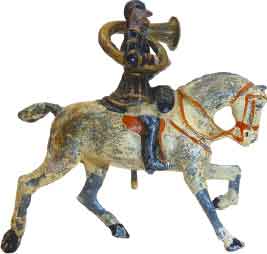
Picture 41: Movable arm bombardon player
Although this change to movable arms did not take place until 1911, I show this picture here while we are looking at set 101. Conventional wisdom tells us that the bombardon was dropped when movable arms came in, but here is one in movable arm format with an early ‘blue’ set 101. This must be one of the rarest bombardon players – I have certainly never seen one before. I wonder if there is an equivalent infantry figure playing a bombardon with movable arms. B
Summary of models produced in the First Age of Britains
In the seven start- up years to the end of 1899, Britains had created the following regular sets, not counting small size, cheap, gilt, composite or multiple display sets:
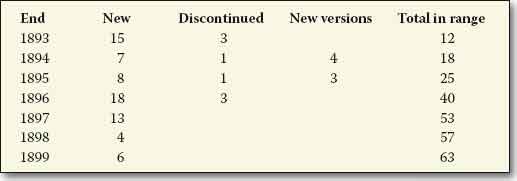
This was achieved through the use of just fifty-one models not counting small size where there were a further eleven models. By 1899, four of the initial ‘Germanic’ models had been discarded, and, partially with the intention of routing the too imitative competition, the drive was on to update and standardise every model.
These original fifty-one standard or near standard scale models produced in the First Age include collectively the most sought after in the Britains range, and are known as ‘Ancient Britains’. I list them below in order of appearance, with the ‘Regular’ sets in which they appeared during the First Age (The numbers quoted are from my ‘Britains Toy Soldiers 1893-1932’ Figure type and sequence glossary).
All or any of the sets in the first 101 numbers, any of the individual models or any combination of them would, for me, constitute a beautiful cameo or iconic item. There are many variations and story threads running through them, and taken as a whole they are among the most artistic and fascinating of all Britains figures. No-one could call any of them mundane or boring. I have now devoted in all over two hundred pages of my writings to just these initial seven years, and have never tired of speculating upon the many unsolved mysteries that remain concerning them and their German and British competititors.
Mounted horsemen (seventeen models)
1893 |
1.1 Germanic Household Cavalry, sets 1,2,3 Germanic Scots Grey, sets 6,7 6.1 Germanic Lancer, sets 4,5,10 2.1 Donkey Horse Hussar, sets 12,13,83 |
1894 |
3.1 Officer on rearing horse, sets 1,2,3,12,13,72,73,83 |
1895 |
9.1 Officer on head down spindly horse, sets 19,28,36 |
1896 |
7.2 Dr Jameson 6,38 |
1897 |
1.2 Standard Household Cavalry, tin sword, sets 1,2,3,72,73 |
1899 |
2.2 Pony Horse, sets 81,99,100 Life Guard mounted bandsman set 101 |
Foot (twenty-three models)
1893 |
Germanic plug-handed Fusilier, set 7 16.6 Plug-handed Highlander, sets 11,15,77,88 |
15.1 Standing on guard, sets 16,17,18,29 West India Regiment, set 19 |
|
1895 |
Soldier to Shoot, set 25 17.1 Germanic fixed arm Infantryman, sets 29,36 |
1896 |
23.3 Slotted-arm Musician, sets 27,37 |
1897 |
17.2 Valise pack Marching man, sets 7,9,26,35,74,75,76,82,91,92,93 Royal Navy Petty Officer, running, sets 78,79,80 |
1899 |
16.1 Pigeon-chested running infantryman, sets 93,96,97,98 |
Other figures (eleven models)
1895 |
Mule, set 28 |
1896 |
Artillery team horse with driver, set 39 |
1897 |
Goat Mascot, set 74 |
RARITY All figures made before 1900, known as Ancient Britains. If they are in sets, and especially in boxes, so much the better. VALUES Single row sets of 19th century Britains figures in good or better condition normally vary between £200 and £5,000 at auction, the average being around £400 unboxed and £800 boxed.
From 1900, Britains plans to copyright their figures to counter the inroads of their British competitors came to fruition, thus ushering in the Second Age of Britains.
Sequencing – The 1st Life Guards
It would be instructive at this stage to map where we are going for the next five ages using as a vehicle the career of set 1, the first set, the 1st Life Guards. As well as being the very first set, the Life Guards had a particularly prominent career with Britains (see jacket illustration). It is curious, for that reason, that they did not even get the uniform right until the mid-1930s, when they acknowledged the amalgamation of the 1st and 2nd Life Guards that took place in 1922, and after forty years of painting them with red collars, finally gave them the blue collars they wear in real life.
The very first models, issued in 1893 (1st version see pictures 19 and 19A), were the Germanic Life Guard, with a plain cuirass in bare metal without a crossbelt. This figure was fixed arm, and a tin sword was inserted into the right hand. In 1894 (2nd version) the officer on the rearing horse was introduced, and crossbelts were painted onto the Germanic figures. In 1897 (3rd version), with the introduction of the Jubilee souvenir set 72, a new improved fixed-arm figure with tin sword and moulded aiguillettes was designed by William Britain Junior to replace the Germanic figure, and in outline this figure was still in use for the Life Guards at the end of hollowcast production in 1966.
In 1902 (4th version), the troopers were replaced by similar figures with movable arms, known as the one-eared horse, since the ears were represented as one piece. The trooper had aiguillettes, and the sword was quite thick. About 1907, the fixed arm officer was re-worked to stand on a plain rectangular base, and was at the same time also given a movable arm. In 1909, a brand new officer on a horse in a similar rearing stance dated 19.10.1909, was created. At some point during the next ten years the troopers on the one-eared horses started to be moulded without their auguilettes. Was this because there was difficulty in the moulding? At all events, around 1925 (5th version), the one-eared horse was replaced by an undated two-eared version with separated ears. At about the same time, the date for the officer was dropped from underneath the base. These figures then remained the same in set 1 until about 1953, but in the 1930s Britains realised, or had pointed out to them, that the red collars that they had painted onto their Life Guards for about forty years were incorrect, and should be in blue. This was now done for the future.
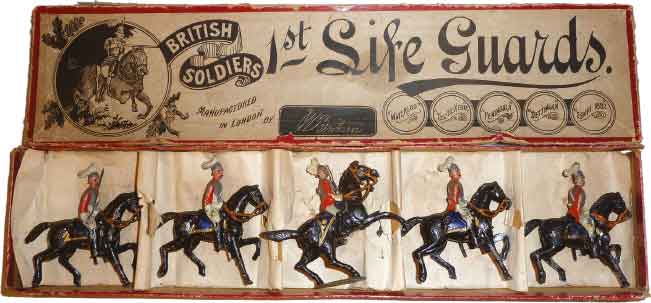
Picture 42: Second version set 1 with compartmented box
As Britains became more confident of success with their toy soldiers, they started to decorate and illustrate the sets more intricately. This example of a second version set 1, with rearing officer, shows an early paper covered compartmented box from around 1895, the individual soldiers being rather better painted than the first version shown in picture 19 above. O
In 1953 it became apparent that new materials in the form of plastics were going to change the face of toy soldiers forever. In a defensive action, Britains tried to brighten up their sets by including a greater variety of soldiers in many of their boxes. For set 1 (6th version), this meant initially installing a new officer based on a cantering mould once used in the Paris factory for cavalry officers and dated 12.2.1903 and 9.5.1905. Then came two different heads for the troopers, the original head with flowing plume and the one used for the Life Guard sentries set 2029. The arms were changed to use one with gauntlets. Shortly afterwards two of the troopers were switched to the short rein Scots Grey horse, so that all the pieces in the box were different.
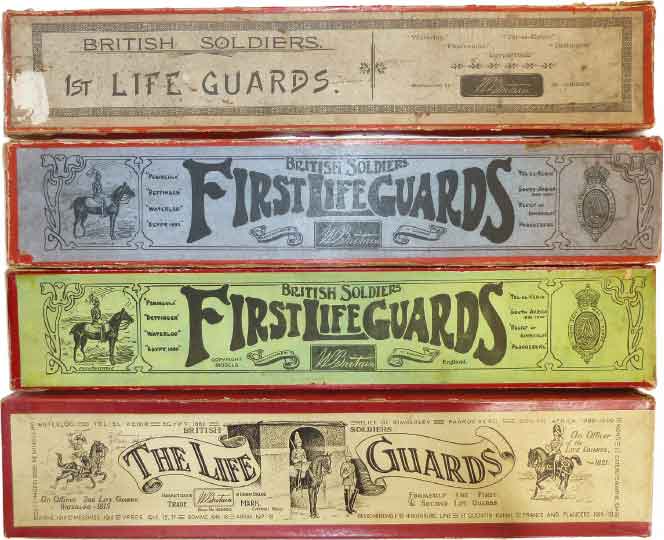
Picture 43; Life Guard sequence of boxes 1
The box at the top dates from before 1898, as it shows no set number. Britains box labels were printed on various coloured stock, so there were a variety of colours for each label, as here with blue and green for the Whisstock version of set 1. The box label at the bottom was used for set 1 from around 1932 until 1961. O
Picture 44: Life Guard sequence of boxes 2
Set 1 in versions 3 (from 1897), version 4 with aiguillettes (from c.1902, officer on rectangular base from 1907), version 4 without aiguillettes and officer dated 19.10.1909 (from 1910). The card insert for this set may be too late for the content, as it includes the trade mark stamp introduced in 1926. Bottom row, version 5 (from c.1925), in the cavalry box with card cut out introduced c.1932. O
This was the last version in hollowcast, but when the set went into window box packaging as set 9205, with one less figure (one of the Scots Grey style figures was dropped), the face painting for sets 1 and 2 alone among all the surviving hollowcast sets changed to leave out the application of eyes, mouth and cheeks, and add in a gold chinstrap instead. This style I have nicknamed ‘faceless’ paint, and is similar to the way that more recent diecast figures are done, where the facial features are better defined in the moulding.
The first Herald Life Guard figures were issued in early 1954, and so overlapped with the hollowcast variety for twelve years. They were in the Britains range until 1976. There was an early version of the horse made in two halves of cellulose acetate which was quickly replaced by a bulkier horse of solid Alkathene in two variations that lasted through until the end of production. As with all the Herald models, price and painting quality were steadily reduced. At no time were facial details included.
Picture 45: Late Life Guard sequence, with ‘faceless’ paint
Set 1 in versions 5 and 6. Top row, version 5 with corrected blue collars c.1937, 2nd row, set 1 in 1948 with post-war cream insert card. 3rd row, in 1954 with new officer and selection of different heads, plumes flowing or straight down, but all still on the original horse type. 4th row, in 1956 with two short rein Scots Grey horses included, and finally in 1963, converted to set 9205 in a window box, with ‘faceless ‘paint. O
The true successors to the hollowcast Life Guards were in the Eyes Right range, and these were introduced in 1968, just a year after the last hollowcast Life Guards were deleted. The main market for these very traditional looking figures proved to be as souvenirs of London, and it was not enough to justify their continuation past 1973, just five years. Once the Herald mounted figures had gone, the only Life Guard in the Britains range was the sentry on foot, one of just three diecast New Metal Models, available from 1974.
The next mounted model Life Guard, a diecast in the Metal Models range, was first produced in 1984. It was mounted on a horse the mould for which had been acquired from Airfix and converted for diecasting. It was considerably bulkier in appearance than either the hollowcast or the Herald figure. It was fitted with plastic saddlecloth and sword, but was also issued as a Limited Edition with specially moulded solidcast arms that included a metal sword. In 1989 the figure was mounted onto a base, so that it could be fitted to the new hard plastic packaging that came into use in that year. This model is still being produced today, sold mostly in the London tourist market, and looks, after 29 years in production, as though it could go on to challenge the longevity of the 1925 two-eared hollowcast figure, which lasted for 41 years. The role of the Life Guards in the Britains story is celebrated by the jacket for this book.
There have also been a number of other ceremonial Life Guard figures produced since 1989, notably in set 00255, The Sovereign’s Escort.
Look back at what I have written in simply charting the course of Britains basic toy Life Guards from start to finish, without going fully into the other sets in which they have been included, other small details of the uniform, such as white or black sheepskin saddle cloths, representations of aiguillettes or crossbelts, or indeed the 2nd Life Guards, different models of the Life Guards or the Royal Horse Guards, with their attendant small size or second grade figures. It is as well we are not going into that detail for every regiment, but offering with this example a taste of what there is to explore when you collect Britains in just one of the many themes through the seven ages!
